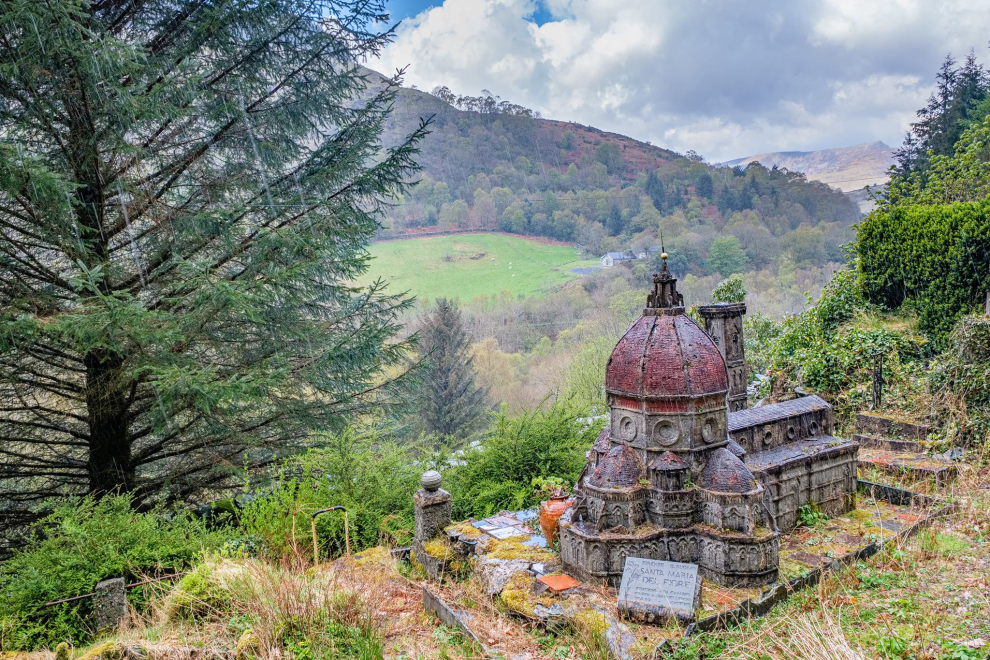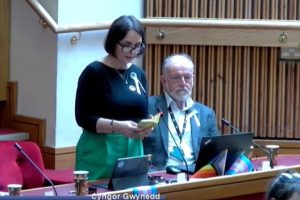Volunteers have been left astonished by the sheer number of replica buildings scattered across a small woodland in southern Eryri, dubbed “Little Italy”. As the site has been cleared, hundreds of ornate Mediterranean-style structures have been revealed.
Jonathan Fell, the site’s enthusiastic curator, expressed his amazement: “Every time I pulled away more ivy, I thought: ‘Bloody hell, there’s another one’.” Approximately 200 objects have been discovered so far, including buildings, statues, plaques, and various curiosities. Before conservation efforts began a few years ago, only about 30 structures were visible.
The area features iconic Italian structures such as the Duomo of Florence and the Rialto Bridge of Venice. Among the more recent finds are unexpected elements: a miniature English village, a cat cemetery, and what appears to be a Venetian canal, which may once have carried flowing water.
Each discovery has deepened Jonathan’s admiration for the site’s creators, Mark Bourne and his wife Muriel. He views their homage to Italian architecture, located on the fringes of Corris between Dolgellau and Machynlleth, as a testament to their obsession, perseverance, and creativity.
Jonathan dismisses comparisons to Portmeirion, the renowned Italianate village in Porthmadog. “I absolutely love this place,” he said. “I don’t like to call it folk art because it’s much more than that. It’s such an important site – one of the most important in Wales, far more so than Portmeirion, which had all that money thrown at it.”
Mark Bourne, who previously ran a caravan site and poultry unit, would often disappear to Italy for weeks, returning with sketchbooks filled with architectural drawings. He then set about recreating these structures, sometimes with help from local volunteers. Using old materials like wash boilers and hub caps for structure, he would wrap them in moulded chicken wire ready for concreting.
Over a quarter of a century, Bourne hauled thousands of buckets of water and ballast from the Afon Deri in the valley below to mix with concrete. A modest Datsun 4×4 and trailer did some of the heavy lifting, but sheer physical strength was required for the final stretch up the garden’s steep slope, which ranges from 30 to 45 degrees.
Jonathan still finds it hard to comprehend the scale of the task. “This guy spent 25 years carrying hundreds of tonnes of concrete, water, and ballast up a hillside with a 30 to 45-degree slope,” he said. “At its steepest, it’s hard to walk up, and he had to build paths before erecting a workshop, laying foundations, and starting on the objects.”
Jonathan speculates that Mark might have used a mixer for the concrete, but even then, he would have needed a team to help transport it up the hill. “How he did it, I’ve no idea,” he said.
To protect the cottage and gardens, the site was placed into a trust before the Covid pandemic. The trustee, Richard Withers, convinced family friend Jonathan to coordinate the rescue of what’s known locally as “Mark’s Folly”, a name given by villagers who thought the creator was “crazy”.
Jonathan, who previously worked as a designer and conservationist at Brighton’s Royal Pavilion, faced a monumental task in Corris: the site resembled a jungle, with structures falling apart and tree roots undermining foundations. With a team of helpers, they’ve begun shoring up the site, using lime mortar to mend cracks and leave behind conservation “fingerprints”. Jonathan believes the project could take 10 years to complete.
“At least you can actually walk around the place now,” he said. “You could never do that before. A lot of buildings still need stabilising and conserving, and we need to identify the materials needed to achieve this.”
The team discovered a miniature Italian street with a row of perfectly proportioned houses. Initially puzzled, they eventually realised the street was once water-fed from a small spring. Jonathan, thrilled with the find, exclaimed: “I ran down the slope shouting: ‘I’ve found Venice!’ It looks like it was a canal, not a street, but I can’t prove it.”
Another surprising discovery was a quintessential English hamlet hidden beneath ferns and ivy. Months later, the team realised the church and timber-framed thatched cottages were an exact match for a scene depicted on red Stafford teacups placed on a concrete shelf elsewhere in the garden.
“There are hundreds of objects here – at least 200 – and there might still be more to find,” sighed Jonathan. “But I’m pretty confident we’ve found most of what he built. At least 95% of the garden has now been uncovered.”
As they cleared the site, they found half-finished buildings, which Jonathan calls the “f**k-ups” where Mark started and stopped because he wasn’t happy with them. Equally thrilling were the “ghosts” they unearthed – remnants of the site’s working life, from discarded children’s spades to unused drill holes now filled with moss.
Near the Duomo, they found the cathedral, twice the size of a washing machine, built on a sloping rock. Jonathan said: “As a museum curator, you look for things that shouldn’t be there, a bit like an archaeologist.”
















